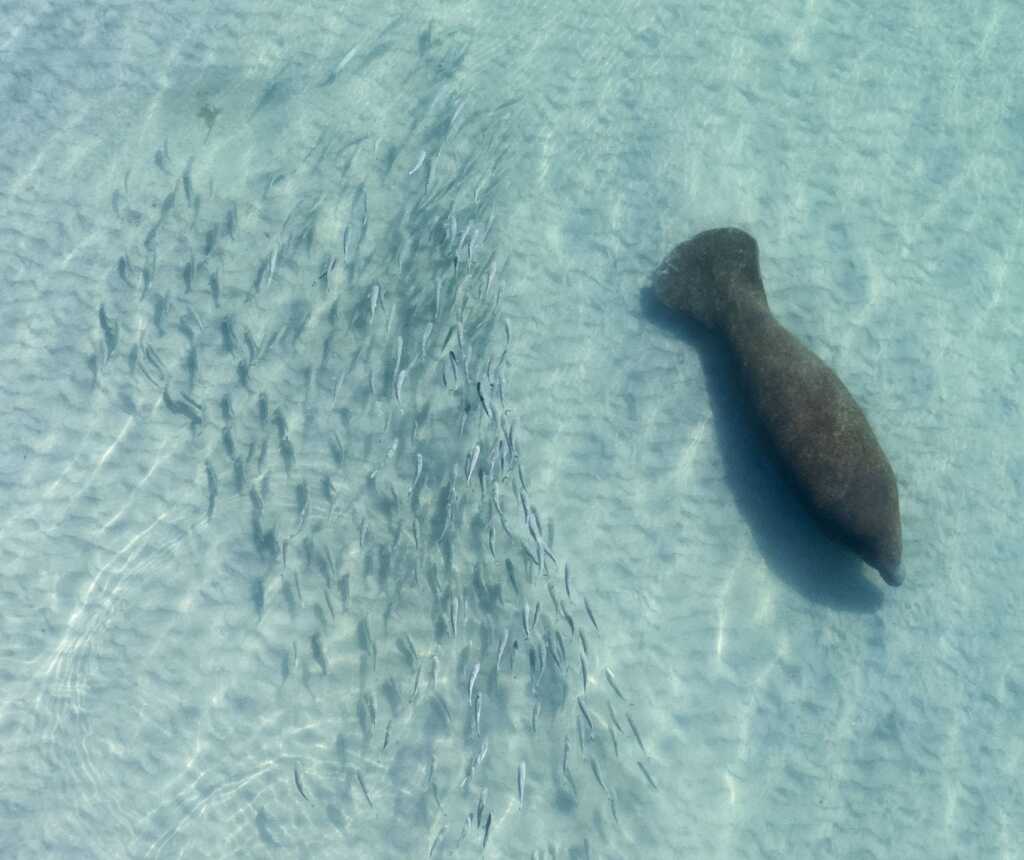Deep Dive: Baby manatees are dying – and it might be a sign of recovery
Deep Dive: Baby manatees are dying – and it might be a sign of recovery
So far this year, 133 baby manatee have been found dead in Florida, a mortality rate more than twice the five-year average and more deaths than any other entire year since the state began keeping records in 1974.
Still, manatee experts see a silver lining to the horribly dark cloud: For the past couple of years, most female sea cows weren’t able to get pregnant at all.

Scientists think the deaths — most of them stillborn calves — are related to the massive manatee die-offs in 2021 and 2022 when algal blooms covered much of the Indian River Lagoon in Brevard and Volusia counties.
Nutrient pollution from fertilizer runoff and septic tanks triggered the algal blooms, which clouded the lagoon’s water, preventing sunlight from reaching seagrass growing on the bottom.
Seagrass is the major food source of manatees, and many of them starved to death. Animals recovered by the Florida Fish and Wildlife Conservation Commission (FWC) were severely underweight, with deteriorated muscle and fat and atrophy of the liver, heart and other organs.
Ironically, the die-off came four years after the U.S. Fish and Wildlife Service said the manatee population was on the upswing and downlisted sea cows from endangered to threatened, much to the consternation of environmentalists.
Manatee deaths totaled 1,100, a record, in 2021. Of those, 516 manatees died in the Indian River Lagoon, and 358 in Brevard County alone.
Many of the malnourished female manatees that didn’t die were unable to reproduce, which led to very few manatees being born, especially along the Indian River Lagoon.
Now, more female manatees are getting pregnant; but they’re still recovering from malnourishment, said Beth Brady, a senior conservation associate at the Save the Manatee Club, and many haven’t gotten to the point where they can maintain the pregnancy.
The fact that most of the dead calves found this year are stillborn is also good news, scientists say, because it indicates that there aren’t any new diseases threatening manatees.
The FWC doesn’t keep statistics on manatee birth rates, said Tom Reinert, the FWC’s manatee rescue and recovery coordinator for the East Coast; but the agency staffers report observing many liver calves in the wild.
“So the good news is that manatees are able to reproduce again,” she said, “and that’s a sign that things are getting back to normal.”

But will ‘back to normal’ last?
But the good news will continue only as long as seagrass continues to have a resurgence in the Indian River Lagoon.
In July, VoteWater reported that the lagoon’s seagrass acreage grew back by 24% in just two years, from a record low of 19,821 acres in 2021 to 24,521 acres in 2023.
Still, that represents only about 30% of the 80,434 acres of seagrass found in 2007, the acreage biologists say is needed for a healthy lagoon.
“I’m cautiously optimistic,” Brady said, “but we’re seen seagrass come back in the lagoon before, only to see it be gone in another year.”
Seagrass seems to be recovering best in the Mosquito Lagoon section of the northern IRL, Brady said, “so we really need to concentrate efforts to protect manatees (from boat strikes) there.”
Through August, 69 manatees have been killed by boat strikes, an average of 8.625 a month. If that monthly rate continues through the end of the year (which is doubtful because boat traffic typically peaks in the summer), the death toll would total 103.5.
The worst year for manatee deaths by boat strikes was 2019, when 137 were killed. That year, boat strikes killed 27 manatees in Lee County. Along the northern Indian River Lagoon, boats killed 16 manatees in Brevard County and 12 in Volusia County.
Since then, boat-related manatee deaths fell to more normal (but still unnecessarily high) numbers of 91 in 2020, 104 in 2021, 76 in 2022 and 89 in 2023.
Overall, manatee deaths in Florida are well above average but nowhere close to the record set during the mass die-off.
Over the first 24 years of this century (2000 through 2023), a total of 12,252 manatee deaths have been recorded, for an average of 510.5 per year.
Through Sept. 13, the last time the FEC updated data, 451 manatee deaths have been recorded this year, which extrapolates to a total of 640.5 deaths for the entire year — 130 more deaths than the annual average so far this century.
Brevard County, which has the longest stretch of Indian River Lagoon waterfront, is the deadliest county with 76 recorded deaths. Lee County on the Gulf Coast is No. 2 with 72 manatee deaths through Sept. 13.
Of this year’s manatee deaths, 146 (32%) weren’t necropsied to determine the cause of death, a troubling fact because we need to know as much as possible about what’s happening — and what’s killing — Florida’s beloved sea cows.
The FWC says there are just too many dead manatees reported in the state to perform necropsies on them all. The agency has implemented new protocols for choosing which manatee carcasses to recover and necropsy and says it still records all deaths and recovers some information from them all.
In some good news for manatees, a federal judge in mid-September refused to dismiss a lawsuit claiming Florida violated the Endangered Species Act by allowing discharges from sewage treatment plants and septic systems into the Indian River Lagoon, which led to the massive die-off.
U.S. District Judge Carlos Mendoza rejected a motion by the Florida Department of Environmental Protection to toss out the lawsuit filed in 2022 by the environmental group Bear Warriors United, according to Orlando Weekly.
Anyone who sees a dead or distressed manatee should call FWC’s Wildlife Alert hotline at 888-404-3922.


